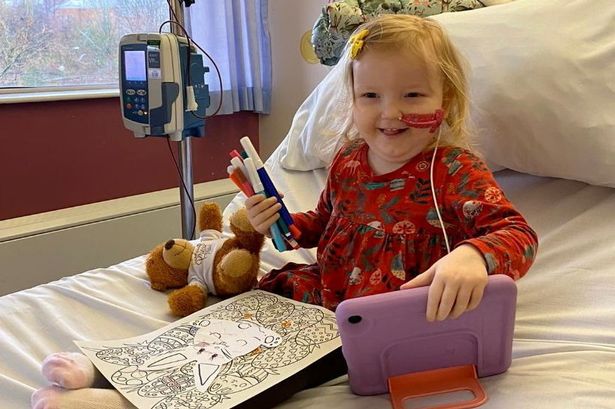Four-year-old Gracie McHugh’s world took an unexpected and devastating turn when she suddenly lost the ability to walk. This alarming symptom led to a series of medical investigations that ultimately revealed a heartbreaking diagnosis: acute lymphoblastic leukemia (ALL). ALL is a type of blood cancer that originates in the bone marrow, the spongy tissue inside bones where blood cells are produced. In ALL, immature white blood cells, known as lymphoblasts, multiply uncontrollably, crowding out healthy blood cells and disrupting the body’s ability to fight infection, transport oxygen, and control bleeding. For a four-year-old like Gracie, this diagnosis marked the beginning of a challenging journey through intensive treatments and their associated side effects.
Gracie’s inability to walk, the initial red flag that prompted medical attention, likely stemmed from the leukemia’s impact on her bone marrow and blood cell production. The overabundance of lymphoblasts in the bone marrow can cause pain and weakness in the bones and joints, making movement difficult and even impossible. Furthermore, the suppressed production of healthy red blood cells, responsible for carrying oxygen throughout the body, can lead to anemia, characterized by fatigue and weakness. This combined with the potential for leukemia cells to infiltrate the central nervous system, further contributing to neurological symptoms like difficulty walking, paints a picture of the complex interplay of factors that likely contributed to Gracie’s initial presenting symptom.
The diagnosis of ALL typically involves a combination of physical examinations, blood tests, bone marrow biopsies, and imaging studies like X-rays and CT scans. Blood tests reveal abnormalities in the number and types of blood cells, while a bone marrow biopsy, which involves extracting a small sample of bone marrow for examination, confirms the presence of leukemic cells and helps classify the specific type of leukemia. Imaging studies can help determine the extent of the disease and identify any areas where the leukemia has spread. Understanding the specific subtype of ALL is crucial for tailoring the treatment plan and predicting the prognosis.
The treatment for ALL, particularly in children, has significantly advanced in recent decades, with cure rates now exceeding 85% in many cases. The primary treatment approach involves chemotherapy, a systemic therapy that uses powerful drugs to kill cancer cells throughout the body. Chemotherapy for ALL is typically administered in phases, including induction therapy to achieve remission (the absence of detectable leukemia cells), consolidation therapy to eliminate any remaining leukemia cells, and maintenance therapy to prevent relapse. Depending on the specific characteristics of the leukemia, other treatment modalities like targeted therapy, radiation therapy, and stem cell transplantation may also be employed.
While the advancements in treatment are encouraging, the journey through ALL treatment is undeniably arduous, especially for young children. Chemotherapy can cause a range of debilitating side effects, including nausea, vomiting, hair loss, infections, and fatigue. These side effects can significantly impact a child’s quality of life, hindering their ability to engage in normal activities like playing, attending school, and interacting with friends and family. Supportive care, including medications to manage side effects, nutritional support, and psychological counseling, plays a vital role in helping children and their families cope with the challenges of treatment.
Gracie’s story, while heartbreaking, highlights the importance of early diagnosis and access to effective treatment. Her initial symptom, the inability to walk, while seemingly nonspecific, ultimately led to the discovery of a life-threatening condition. The advancements in ALL treatment offer hope for a positive outcome, and Gracie’s journey serves as a testament to the resilience of children facing adversity. The ongoing research and development of new and improved therapies continue to push the boundaries of cancer treatment, offering the promise of even better outcomes for children diagnosed with ALL in the future. The support of family, friends, and the medical community is invaluable in navigating this challenging journey, providing strength and hope during a time of immense vulnerability.














